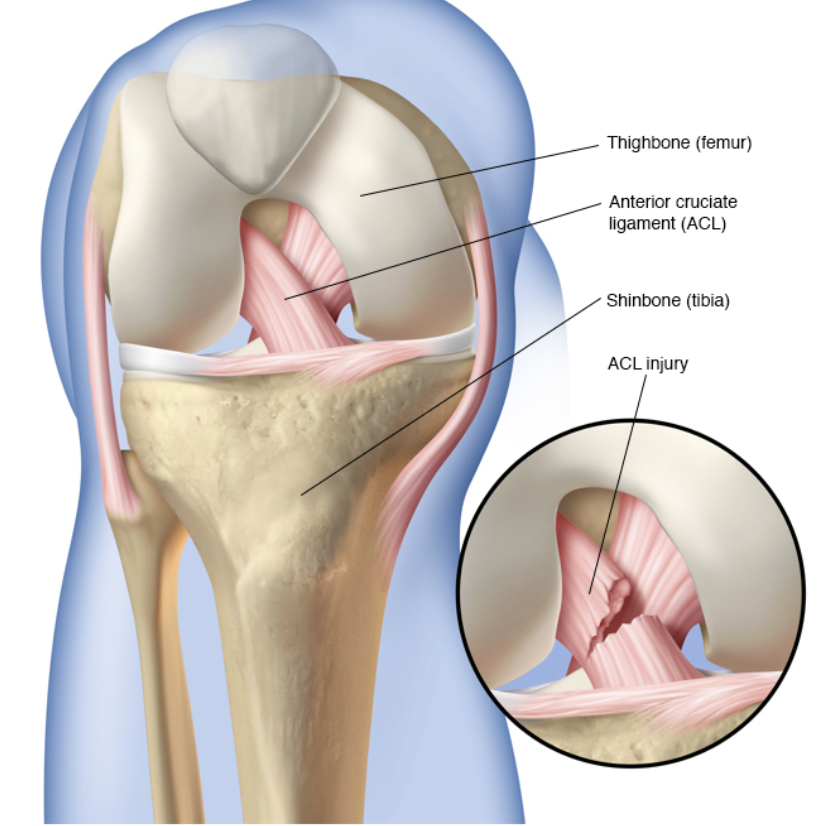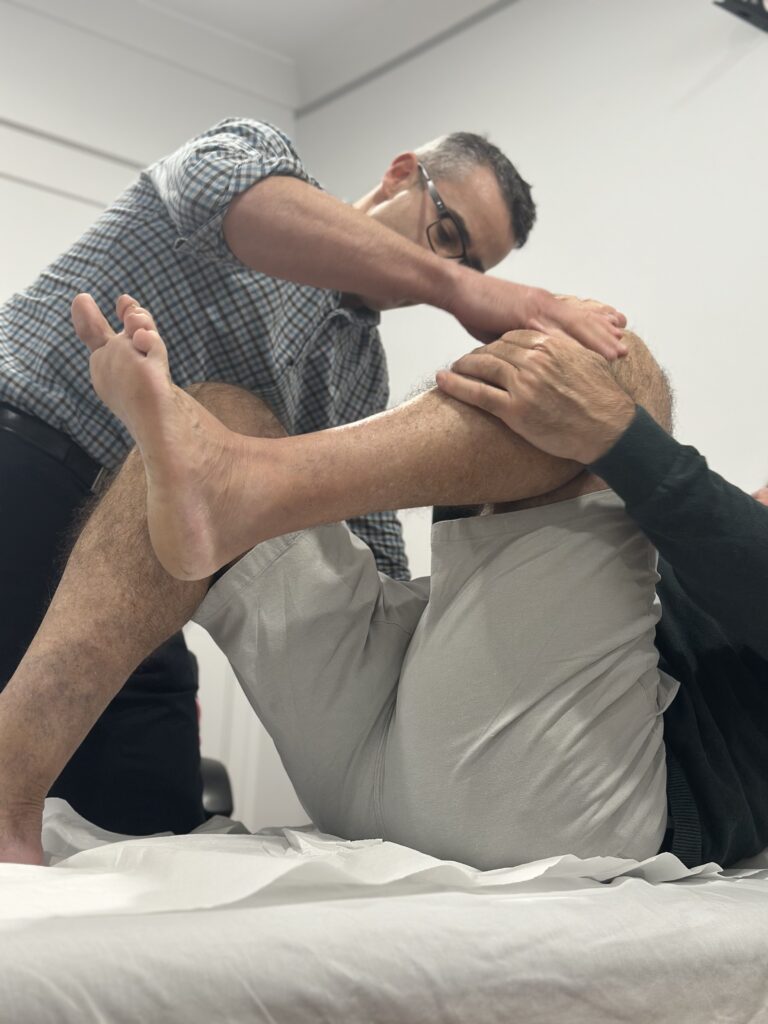ACL Tears & Injuries
A common knee ligament injury that can affect stability, movement, and participation in everyday or sporting activities.
An Anterior Cruciate Ligament (ACL) injury is a common knee injury, particularly among athletes involved in high-demand sports such as soccer, basketball, and skiing. The ACL is one of the key ligaments that helps stabilise your knee joint. Understanding the nature of ACL injuries, their symptoms, diagnosis, and treatment options is crucial for effective management and recovery.
- WHAT IS AN ACL TEAR?
- ACL SPRAIN VS TEAR: WHAT’S THE DIFFERENCE?
- WHO IS MOST AT RISK FOR AN ACL INJURY?
- COMMON CAUSES OF ACL TEARS: HOW DOES IT HAPPEN?
- RECOGNISING THE SYMPTOMS OF AN ACL TEAR
- HOW ARE ACL INJURIES DIAGNOSED?
- DOES AN ACL INJURY MEAN THE END OF YOUR SPORTING CAREER?
- EXPLORING TREATMENT OPTIONS FOR ACL INJURIES

WHAT IS AN ACL TEAR?

The anterior cruciate ligament (ACL) is a key stabilising ligament in your knee joint. It connects the femur (thigh bone) to the tibia (shin bone) and plays a critical role in keeping your knee stable during activities like running, jumping, and pivoting. The ACL is especially important in preventing the tibia from sliding too far forward relative to the femur and provides rotational stability to the knee. Injuries to the ACL are common in sports and high-impact activities where sudden changes in direction or awkward landings occur.
An ACL tear occurs when the anterior cruciate ligament becomes partially or completely ruptured. Most ACL tears are complete tears and can be torn from the femur, tibia, or in the centre of the ligament. The most common location for a tear is the centre of the ligament.
Tears are often classified into grades:
- Grade 1: Mild stretching or sprain without instability.
- Grade 2: A partial tear with some instability.
- Grade 3: A complete tear where the ligament is fully severed.
ACL tears often occur alongside other injuries, such as damage to the meniscus or other ligaments in the knee.
ACL SPRAIN VS TEAR: WHAT’S THE DIFFERENCE?
While the terms are often used interchangeably, there is a difference between an ACL sprain and a tear:
- Sprain: This refers to stretching or minor damage to the ligament without a full rupture. Sprains are less severe and may heal with conservative treatment.
- Tear: This occurs when the ligament is partially or fully severed, often requiring surgical intervention for athletes or highly active individuals.
- Dr Martin can assess the severity of your injury during a consultation and discuss the most appropriate treatment options.
WHO IS MOST AT RISK FOR AN ACL INJURY?

People of all ages, physical conditions, and abilities can tear an ACL however certain factors may increase the likelihood of an ACL injury:
- Sports Participation: Activities that involve pivoting, sudden stops, or jumping, such as soccer, netball, basketball, and skiing.
- Gender: Women are more prone to ACL injuries due to differences in anatomy, hormonal influences, and biomechanics.
- Previous Injury: A prior ACL injury increases the risk of reinjury.
- Muscle Imbalances: Weakness or poor coordination in the muscles surrounding the knee.
- Poor Technique: Improper landing mechanics or pivoting can contribute to injury.
ACL injuries are also common in children, especially as youth sports become increasingly competitive. Until recently, ACL treatment for children and adolescents was exclusively nonsurgical. This was because traditional ACL surgery techniques could cause growing children to develop a leg length discrepancy or growth deformity. However, newer surgical techniques have made surgical treatment an option for many kids and teens.
COMMON CAUSES OF ACL TEARS: HOW DOES IT HAPPEN?
ACL injuries commonly occur during activities that place stress on the knee joint, such as:
- Sudden Stops: Quickly stopping after running or sprinting.
- Pivoting Movements: Rapid changes in direction or pivoting on a planted foot.
- Jumping and Landing: Incorrect landing techniques from jumps, particularly in sports like basketball, netball or volleyball.
- Direct Impact: Collisions or impacts to the knee, common in contact sports
Dr Martin may recommend injury prevention strategies, including strength training and technique improvements.
RECOGNISING THE SYMPTOMS OF AN ACL TEAR
The symptoms of an ACL injury can vary depending on the severity, but common signs include:
- A “Pop” Sound: Many people report hearing or feeling a “pop” in the knee at the time of injury.
- Severe Pain: Immediate and intense pain that can prevent continuation of activity.
- Swelling: Rapid swelling within a few hours of the injury.
- Instability: Feeling of instability or “giving way” when putting weight on the affected leg.
- Limited Range of Motion: Difficulty moving the knee fully, accompanied by tenderness along the joint line.
If you suspect an ACL tear, seek prompt medical attention to minimise further damage.
HOW ARE ACL INJURIES DIAGNOSED?
Diagnosing an anterior cruciate ligament (ACL) injury involves a combination of a detailed history, physical examination, and imaging tests. This process helps confirm the diagnosis and rule out other potential injuries within the knee.
- Patient history and symptom review: Dr Martin will begin by asking how the injury occurred and what symptoms followed. ACL tears often happen during sports or high-impact activities and may be accompanied by a popping sound, immediate swelling, and a feeling that the knee “gave way.” Understanding the mechanism of the injury is an important first step in reaching a diagnosis.
- Physical examination: A hands-on assessment of the knee is used to check for instability, swelling, and pain. Specific tests, such as the Lachman test, pivot shift test, or anterior drawer test, help evaluate the integrity of the ACL. These tests apply gentle pressure and movements to determine whether the ligament is functioning properly.
- Imaging: While a physical exam can strongly suggest an ACL tear, imaging is usually needed to confirm the diagnosis and check for any associated injuries.
X-rays may be ordered to rule out fractures or other bone injuries, although they do not show the ligament itself.
MRI (Magnetic Resonance Imaging) is the most accurate test to assess ACL damage. It provides detailed images of the soft tissues in the knee, including the ACL, meniscus, cartilage, and surrounding ligaments.
- Further evaluation: In some cases, particularly if the knee is very swollen or painful, a follow-up assessment may be required once the inflammation has settled. If surgical treatment is being considered, imaging and examination results will be used to plan the best approach for your individual needs.
Early diagnosis is important to reduce the risk of further knee damage and to guide decisions about treatment and rehabilitation.

DOES AN ACL INJURY MEAN THE END OF YOUR SPORTING CAREER?
As recently as twenty years ago an ACL injury, especially a rupture or a tear, was most likely a career-ending occurrence for most athletes. Thankfully, today’s orthopaedic techniques to repair and reconstruct the ACL have advanced greatly. The ability to return an athlete to sport is now a reality for many. Partnering with a surgeon like Dr Martin, who has extensive experience and success with a track record for returning athletes to sport is key to a successful career beyond an ACL injury.
EXPLORING TREATMENT OPTINS FOR AN ACL INJURY?
Not all ACL injuries require surgery. A strain or sprain may heal on its own with proper rest and rehabilitation. The severity of symptoms the condition of the ACL will determine if surgery needs to occur.
Non-Surgical Treatment:
If the ACL injury does not cause instability in the knee joint, physiotherapy may be enough to heal the joint. Consideration should also be taken as to the future plans of the patient. For instance, if the patient does not require the use of their ACL for sports or daily activity, they may not require surgical intervention. For ACL injuries that do not cause instability and are not torn, the following non-surgical treatments may be recommended:
- NSAIDs (non-steroidal anti-inflammatory drugs): to relieve pain and reduce swelling
- RICE: Rest, ice compression and elevation
- Bracing: To protect the knee from instability and allow it to heal
- Crutches: Keeping weight off the injured knee and allowing it to heal
- Physiotherapy: Strengthens the muscles around the knee and maintains range of motion.
Surgical Treatment:
An ACL tear will not heal on its own because there is no blood supply to the ligament. Surgery is needed to restore stability and normal knee function and can be done arthroscopically. Dr Martin is highly skilled in ACL Reconstruction Surgery, which removes damaged fragments of the torn ACL and replaces it with a soft tissue graft. This graft could be from your own body (autograft) or a donor (allograft). Dr Martin uses minimally invasive techniques to ensure the best possible outcomes.
